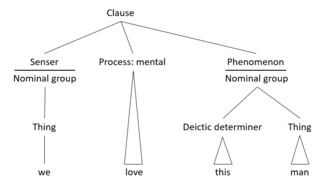Related Research Articles

Functional linguistics is an approach to the study of language characterized by taking systematically into account the speaker's and the hearer's side, and the communicative needs of the speaker and of the given language community. Linguistic functionalism spawned in the 1920s to 1930s from Ferdinand de Saussure's systematic structuralist approach to language (1916).
The following outline is provided as an overview and topical guide to linguistics:
In linguistics and related fields, pragmatics is the study of how context contributes to meaning. The field of study evaluates how human language is utilized in social interactions, as well as the relationship between the interpreter and the interpreted. Linguists who specialize in pragmatics are called pragmaticians. The field has been represented since 1986 by the International Pragmatics Association (IPrA).
Cognitive linguistics is an interdisciplinary branch of linguistics, combining knowledge and research from cognitive science, cognitive psychology, neuropsychology and linguistics. Models and theoretical accounts of cognitive linguistics are considered as psychologically real, and research in cognitive linguistics aims to help understand cognition in general and is seen as a road into the human mind.
William Labov is an American linguist widely regarded as the founder of the discipline of variationist sociolinguistics. He has been described as "an enormously original and influential figure who has created much of the methodology" of sociolinguistics. He is a professor emeritus in the linguistics department of the University of Pennsylvania and pursues research in sociolinguistics, language change, and dialectology. He retired in 2015 but continues to publish research.
In semiotics, a sign is anything that communicates a meaning that is not the sign itself to the interpreter of the sign. The meaning can be intentional, as when a word is uttered with a specific meaning, or unintentional, as when a symptom is taken as a sign of a particular medical condition. Signs can communicate through any of the senses, visual, auditory, tactile, olfactory, or taste.
In semantics, mathematical logic and related disciplines, the principle of compositionality is the principle that the meaning of a complex expression is determined by the meanings of its constituent expressions and the rules used to combine them. This principle is also called Frege's principle, because Gottlob Frege is widely credited for the first modern formulation of it. The principle was never explicitly stated by Frege, and it was arguably already assumed by George Boole decades before Frege's work.

Discourse analysis (DA), or discourse studies, is an approach to the analysis of written, vocal, or sign language use, or any significant semiotic event.
In semiotics, linguistics, anthropology, and philosophy of language, indexicality is the phenomenon of a sign pointing to some element in the context in which it occurs. A sign that signifies indexically is called an index or, in philosophy, an indexical.

A speech community is a group of people who share a set of linguistic norms and expectations regarding the use of language. It is a concept mostly associated with sociolinguistics and anthropological linguistics.
Text linguistics is a branch of linguistics that deals with texts as communication systems. Its original aims lay in uncovering and describing text grammars. The application of text linguistics has, however, evolved from this approach to a point in which text is viewed in much broader terms that go beyond a mere extension of traditional grammar towards an entire text. Text linguistics takes into account the form of a text, but also its setting, i. e. the way in which it is situated in an interactional, communicative context. Both the author of a text as well as its addressee are taken into consideration in their respective roles in the specific communicative context. In general it is an application of discourse analysis at the much broader level of text, rather than just a sentence or word.
In linguistics and social sciences, markedness is the state of standing out as nontypical or divergent as opposed to regular or common. In a marked–unmarked relation, one term of an opposition is the broader, dominant one. The dominant default or minimum-effort form is known as unmarked; the other, secondary one is marked. In other words, markedness involves the characterization of a "normal" linguistic unit against one or more of its possible "irregular" forms.

Representation is the use of signs that stand in for and take the place of something else. It is through representation that people organize the world and reality through the act of naming its elements. Signs are arranged in order to form semantic constructions and express relations.
Integrationism is an approach in the theory of communication that emphasizes innovative participation by communicators within contexts and rejects rule-based models of language. It was developed by a group of linguists at the University of Oxford during the 1980s, notably Roy Harris.
Michael Silverstein was an American linguist. He was the Charles F. Grey Distinguished Service Professor of anthropology, linguistics, and psychology at the University of Chicago. He was a theoretician of semiotics and linguistic anthropology. Over the course of his career he created an original synthesis of research on the semiotics of communication, the sociology of interaction, Russian formalist literary theory, linguistic pragmatics, sociolinguistics, early anthropological linguistics and structuralist grammatical theory, together with his own theoretical contributions, yielding a comprehensive account of the semiotics of human communication and its relation to culture. He presented the developing results of this project annually from 1970 until his death in a course entitled "Language in Culture." Among other achievements, he was instrumental in introducing the semiotic terminology of Charles Sanders Peirce, including especially the notion of indexicality, into the linguistic and anthropological literature; with coining the terms metapragmatics and metasemantics in drawing attention to the central importance of metasemiotic phenomena for any understanding of language or social life; and with introducing language ideology as a field of study. His works are noted for their terminological complexity and technical difficulty.
Social semiotics is a branch of the field of semiotics which investigates human signifying practices in specific social and cultural circumstances, and which tries to explain meaning-making as a social practice. Semiotics, as originally defined by Ferdinand de Saussure, is "the science of the life of signs in society". Social semiotics expands on Saussure's founding insights by exploring the implications of the fact that the "codes" of language and communication are formed by social processes. The crucial implication here is that meanings and semiotic systems are shaped by relations of power, and that as power shifts in society, our languages and other systems of socially accepted meanings can and do change.
Functional grammar (FG) and functional discourse grammar (FDG) are grammar models and theories motivated by functional theories of grammar. These theories explain how linguistic utterances are shaped, based on the goals and knowledge of natural language users. In doing so, it contrasts with Chomskyan transformational grammar. Functional discourse grammar has been developed as a successor to functional grammar, attempting to be more psychologically and pragmatically adequate than functional grammar.
Linguistics is the scientific study of human language. It is called a scientific study because it entails a comprehensive, systematic, objective, and precise analysis of all aspects of language — cognitive, social, environmental, biological as well as structural.
In linguistics, stance is the way in which speakers position themselves in relation to the ongoing interaction, in terms of evaluation, intentionality, epistemology or social relations. When a speaker describes an object in a way that expresses their attitude or relation to the object, the speaker is taking a stance. Stancetaking is viewed as a social action that shares the speaker's view of an object with their audience, sometimes inviting listeners to take their own stance as well.
In linguistics, psychology, and literary theory, the concepts of deictic field and deictic shift are sometimes deployed in the study of narrative media. These terms provide a theoretical framework for helping literary analysts to conceptualize the ways in which readers redirect their attention away from their immediate surroundings as they become immersed in the reality generated by the text.
References
- ↑ Goodwin, Charles; Duranti, Alessandro, eds. (1992). "Rethinking context: an introduction" (PDF). Rethinking context: Language as an interactive phenomenon. Cambridge: Cambridge University Press. pp. 1–42. Archived from the original (PDF) on March 12, 2003. Retrieved February 19, 2017.
- ↑ Janssen, T. M. (2012) Compositionality: Its historic context , in M. Werning, W. Hinzen, & E. Machery (Eds.), The Oxford handbook of compositionality , pp. 19-46, Oxford University Press.
- ↑ Finkbeiner, Rita; Meibauer, Jörg; Schumacher, Petra B. (2012). What is a Context?: Linguistic Approaches and Challenges. John Benjamins Publishing. ISBN 978-9027255792.
- ↑ Silverstein, Michael (1992). "The Indeterminacy of Contextualization: When Is Enough Enough?". In Auer, Peter; Di Luzio, Aldo (eds.). The Contextualization of Language. Amsterdam: John Benjamins Publishing Company. pp. 55–76. ISBN 978-9027250346 . Retrieved February 19, 2017.
- ↑ Anind Dey; Boicho Kokinov; David Leake; Roy Turner (24 June 2005). Modeling and Using Context: 5th International and Interdisciplinary Conference, CONTEXT 2005, Paris, France, July 5-8, 2005, Proceedings. Springer Science & Business Media. ISBN 978-3-540-26924-3.